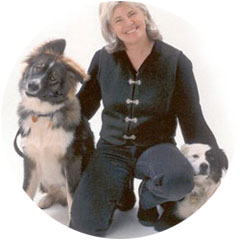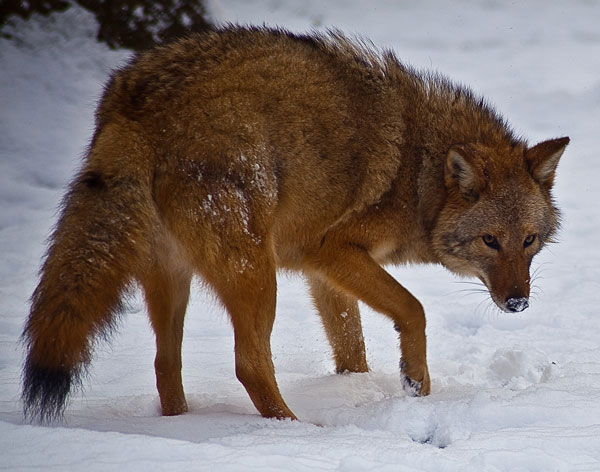Notes from the Field ~ Interview with Chris Schadler
Chris Schadler is a wild canid ecologist who has studied and taught wolf and coyote biology and conservation for over 25 years. She has also raised sheep using only non-lethal methods of predator control. A force to be reckoned with, Chris has dedicated her time to Project Coyote as our New Hampshire and Vermont Representative, inspiring people with presentations about coexisting with coyotes and achieving landmark policy changes for wildlife. We are lucky to have such a multidimensional and dynamic woman in our pack!
I hope you enjoy this interview with Chris and feel inspired to share it with others.
For Wild Nature,
Camilla Fox
Founder & Executive Director
What led you to become a wild canid ecologist?
Back in the 1970s I had an opportunity to volunteer at the North American Wildlife Park Foundation, known as Wolf Park, in Battleground, Indiana. Dr. Erich Klinghammer, an ethologist, founded Wolf Park to study wolf behavior (back before scientists used radio telemetry to capture a pack and observe). My job was to spend a month socializing a wolf pup to humans so that, when he was reintroduced into the pack, he would not be aggressive to veterinarians and other handlers. I learned a great deal about wolf behavior from this experience. When I began graduate study at Antioch in New Hampshire, my thesis focused on the failures of wolf reintroduction in the Upper Peninsula of Michigan and the benefits of natural reintroduction when wolves wandered onto the Peninsula from Wisconsin. Concurrently, I was learning to live with coyotes while I farmed sheep in southern New Hampshire.
As Project Coyote’s New Hampshire and Vermont Representative, you frequently give presentations titled, “Becoming Wolf: Eastern Coyote in New England.” Please tell us what you mean by this and what you see happening with wild canids like coyotes on the East Coast.
On its most granular level, the eastern coyote has wolf DNA (and often some dog DNA), which gives the species more options than its western cousin. Habitat here is prime for a top predator (of deer and moose). Even though the eastern coyote still depends upon rodents, the larger the coyote becomes the better it is at hunting larger prey. The eastern coyote appears to be evolving and adapting to take advantage of the east’s coast abundant larger prey. With every deer taken down by a pack, the definition between coyote and wolf blurs. Will we better tolerate a wild canid with the name “wolf” than one called “coyote”? Some have suggested we call the eastern coyote “coywolf” and many canid researchers are debating this issue as we watch this incredibly adaptable and intelligent wild canid continue to evolve in an ever-changing landscape.
You have raised sheep in a region with abundant predators. How do you protect your livestock from predators and do you have any lessons you’d like to share with other New England ranchers?
The farm I bought had lost many sheep to coyotes. I wanted to see if I could change the culture of the pack to no longer recognize sheep as its primary source of food. The average lifespan of our coyotes is about 3-4 years so I dedicated myself to intensive hazing (using harmless scare tactics to encourage wariness of humans) and protection of my flock. I never left the sheep out at night; they lambed in the barn, and their waste was buried and limed. I only used 4’ livestock fencing with no electric, but I checked the fencing every day and my dogs marked the perimeter of our property. If I saw a coyote anywhere nearby, I would haze and chase them until they stopped looking back at me. While my chosen hazing techniques were initially labor-intensive, I haven’t lost a sheep in 20 years. Within 4 years, the coyote young and yearlings were preying on rodents and also deer and carrion (animal carcasses) in the winter.
You were involved in the 2016 effort to ensure that the New Hampshire Fish and Game Department’s proposal to open a bobcat baiting, hounding and trapping season did not pass. Please tell us about this successful campaign and the coalition you co-founded as a result of it.
My writer friend John Harrigan and I had been talking about the problems with the Fish & Game Commission and we were fed up with having no voice in how wildlife was “managed” in the state. Essentially, non-consumptive users of wildlife are not well represented on the Commission. Our F&G is tasked with more than their dwindling budget can support so they had begun dipping into the General Fund to keep the Department going—which is basically “taxation (on the general public) without representation (on the Commission).” An earlier audit of the Department had recommended broadening the base of representation on the Commission which, they thought, would open “doors” for more money from the public.
Then came the bobcat debate. We worked with Voices of Wildlife to broadcast how the bobcat, with protection under the law, was beginning to make a comeback and how the F&G Commission, bowing under pressure from a few trappers, proposed opening a bobcat hunting season. It inflamed the public. A flurry of letters to the editor, op-eds, and calls and emails to the legislature by thousands of citizens in response to the possibility of a bobcat hunt seemed to shake the legislature and they shot the proposal down.
Buoyed by the public response, we wanted to push further for broadening decision-making responsibility on the Commission and finding sustainable funding for the Department so that the agency would no longer be beholden to trophy hunting and trapping groups. We founded the New Hampshire Wildlife Coalition as a vehicle by which to accomplish this goal, and are working hard to that end.
Can you share a bit about the mission and priorities of the New Hampshire Wildlife Coalition and your efforts to reform state wildlife agency governance?
Go to www.nhwildlifecoalition.org to check out who we are and what we’re about. Our efforts to reform state wildlife governance got off to a great start when the bill we generated passed through the legislature. The bill was for a Governor’s Study Commission to examine the recommendations of an audit done on NH Fish & Game in 2008. The audit recommended broadening the base of the F&G Commission to include members of the general public so that funding from the public, now represented in wildlife decision-making, would be forthcoming.
The F&G Commission ignored the audit and our bill forced a reckoning with it. However, lawmakers changed the bill language to focus only on the financial aspect—how to get more dollars into the F&G budget. They stacked the Commission with hunters, and there was only one of us on the Commission pushing for a look at broadening public input.
If it didn’t hurt so much to do it, I would be laughing at the sham process of it all. We believe we were successful in protecting the bobcat because of the grassroots efforts of the citizenry; we don’t think there is a legislative solution here because of the entrenchment of our 400 representatives.
Vermont banned coyote killing contests in 2018, becoming the second state in the nation to do so. Do you think a similar ban is possible in New Hampshire and, if so, what are the necessary steps to get there?
I think it’s possible but would be a heavy lift in this “Live Free or Die” state. Coyotes are despised in New Hampshire, not just by the hunting group (although not all hunters hate them) but also by many citizens. There is substantial fear and misunderstanding surrounding the coyote—I blame NH Fish & Game for this. When you send out the message that coyotes “waste” deer and offer them for slaughter 365 days a year, people come to think of them as cockroaches with fur.
We face the same battles as Vermont, though, and the Coalition is beginning a grassroots effort to engage the public using Project Coyote’s documentary KILLING GAMES ~ Wildlife In The Crosshairs (tentatively beginning this fall). We can use all the hands we can get! We are proposing a ban on killing contests involving all furbearers and birds and we plan to approach this from an ethical standpoint. It should be a no-brainer to disallow killing animals just for the fun of it.
Chris speaking at Fox Forest Lecture Series, Henniker NH.
Do you see public attitudes changing on the East Coast with regard to predators and the concept of coexisting with them?
Yes. Now, let me remove my rose-colored glasses for a minute. I’ve been giving talks for 30 years and sometimes I wonder if we are any further along than we were back when I started. Actually, I would say the hill has become even steeper to climb. More people are growing chickens and other vulnerable stock and most folks don’t know how to protect them, or feel they don’t need to. The inevitable occurs and the coyote is always to blame. I’m so glad I have those 20 years of sheep farming to talk about.
On a brighter note, educators on every level are tuning into the important role of predators in natural ecosystems and more young kids “get it” than ever before. That’s encouraging. Also, after my talks there are always people who come up and tell me they’ve learned something and that they’ll spread the word. That keeps me going.
Eastern Coyote (CC BY SA 3.0 Forest Wander)
Why did you decide to dedicate your time to Project Coyote?
I can’t quite remember how my relationship with Project Coyote started. Camilla has a great memory so she can fill us in on that! I know that she put me through some amazing interviews before she felt comfortable with me (I’m assuming she’s comfortable with me now!). During that process, I was struck by her seriousness, knowledge and commitment to change this situation for predators—how could I not be inspired to join her pack? Plus, knowing what I do now, I am honored to be among such imminent scientists and so many hard-working, dedicated, articulate and passionate people. The mission of Project Coyote has been my mission through my adult life. I only wish I had more time to give.
I am a Select Person in my town (out here, the Select Boards run the town), I run the Coalition, I chair the Conservation Commission in town and I’m a grandmother. Pretty busy. Too busy.





